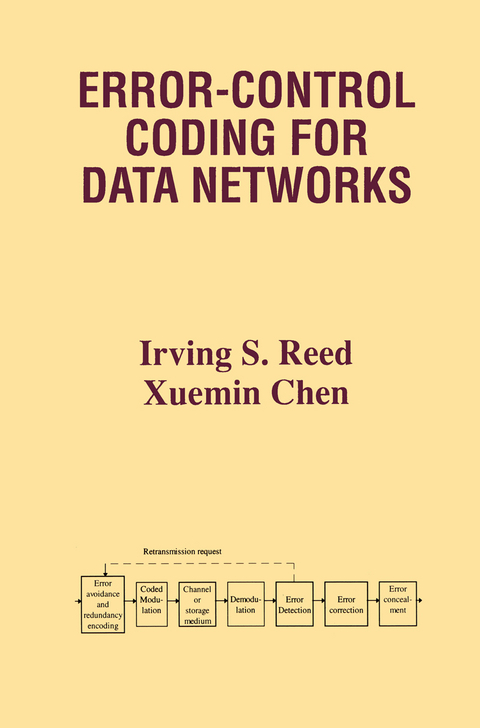
Error-Control Coding for Data Networks
Springer-Verlag New York Inc.
978-1-4613-7273-8 (ISBN)
1 Error-Control Mechanisms.- 1.1 Introduction.- 1.2 Error-Handling Processes in Communication Systems.- 1.3 Examples of Error-Control Strategies.- 1.4 Basic Principles of Error-Control Codes.- 1.5 Noisy Channel Coding Theorem.- 1.6 Decoding Complexity and Coding Performance.- 1.7 Channel Bandwidth and Signal Power.- 1.8 Approaching Shannon Capacity.- Problems.- 2 Elements of Algebra.- 2.1 Groups.- 2.2 Rings.- 2.3 Basic Structures of Fields.- 2.4 Vector Spaces.- 2.5 Finite Fields.- 2.6 Euclid’s Algorithm.- 2.7 Binary Field Arithmetic.- 2.8 Arithmetic Operations in GF(q).- Problems.- 3 Linear Block Codes.- 3.1 Error-Control Block Codes.- 3.2 Definition of (n,k) Linear Codes over GF(q).- 3.3 Decoding of Linear Block Codes.- 3.4 Performance of Algebraic Decoding.- 3.5 Hamming Codes.- 3.6 Reed-Muller Codes.- 3.7 Linear Block Codes for Burst-Error Correction.- 3.8 Product Code.- Problems.- 4 Linear Cyclic Codes.- 4.1 Description of Linear Cyclic Codes.- 4.2 Shift-Register Encoders and Decoders of Cyclic Codes.- 4.3 Binary Quadratic Residue Codes and Golay Code.- 4.4 Error Detection with Cyclic and Shortened Cyclic Codes.- 4.4.1 Error Detection with Cyclic Codes.- 4.4.2 Applications of CRC in Industry Standards.- Problems.- 5 BCH Codes.- 5.1 Definition of the BCH Codes.- 5.2 The BCH Bound on the Minimum Distance dmin.- 5.3 Decoding Procedures for BCH Codes.- 5.4 Algebraic Decoding of Quadratic Residue Codes.- 5.5 BCH Codes as Industry Standards.- Problems.- 6 Reed-Solomon Codes.- 6.1 The State of RS Coding.- 6.2 Construction of RS Codes.- 6.3 Encoding of RS codes.- 6.4. Decoding of (n,k) RS Codes.- Problems.- 7 Implementation Architectures and Applications of RS Codes.- 7.1 Implementation of RS Codes.- 7.2 RS codes in industry standards.- 8 Fundamentals of ConvolutionalCodes.- 8.1 Convolutional Encoder.- 8.2 State and Trellis-Diagram Description of Convolutional Codes.- 8.3 Nonsystematic Encoder and Its Systematic Feedback Encoder.- 8.4 Distance Properties of Convolutional Codes.- 8.5 Decoding of Convolutional Codes.- 8.6 Performance Bounds.- 8.7 Punctured Convolutional Codes of Rate (n-1) /n and Simplified Maximum-Likelihood Decoding.- Problems.- 9 ARQ and Interleaving Techniques.- 9.1 Automatic Repeat Request.- 9.2 Interleaves.- Problems.- 10 Applications of Convolutional Codes in Mobile Communications.- 10.1 Convolutional Codes used in the GSM systems.- 10.2 Convolutional Codes Specified in CDMA Cellular Systems.- 11 Trellis-Coded Modulation.- 11.1 M-ary Modulation, Spectral Efficiency and Power Efficiency.- 11.2 TCM Schemes.- 11.3 Set Partitioning and Construction of Codes.- 11.4 Rotational Invariance.- 11.5 Unequal Error Protection(UEP) Codes and the Pragmatic Approach to TCM Systems.- Problems.- 12 Concatenated Coding Systems and Turbo Codes.- 12.1 Concept of Concatenated Coding System.- 12.2 Concatenated Coding Systems with Convolutional (or Trellis) Codes and RS Codes.- 12.3 Turbo Codes.- Appendix A Some Basics of Communication Theory.- A.1 Vector Communication Channels.- A.2 Optimal Receivers.- A.3 Message Sequences.- Appendix B C-programs of Some Coding Algorithms.- B.1 Encoding and Decoding for Hamming Codes.- B.2 Compute Metric Tables for A Soft-Decision Viterbi Decoder.- About the Authors.
| Erscheint lt. Verlag | 4.10.2012 |
|---|---|
| Reihe/Serie | The Springer International Series in Engineering and Computer Science ; 508 |
| Zusatzinfo | XVI, 549 p. |
| Verlagsort | New York, NY |
| Sprache | englisch |
| Maße | 155 x 235 mm |
| Themenwelt | Sachbuch/Ratgeber ► Natur / Technik ► Garten |
| Informatik ► Grafik / Design ► Digitale Bildverarbeitung | |
| Mathematik / Informatik ► Informatik ► Netzwerke | |
| Informatik ► Theorie / Studium ► Künstliche Intelligenz / Robotik | |
| Technik ► Elektrotechnik / Energietechnik | |
| ISBN-10 | 1-4613-7273-9 / 1461372739 |
| ISBN-13 | 978-1-4613-7273-8 / 9781461372738 |
| Zustand | Neuware |
| Haben Sie eine Frage zum Produkt? |
aus dem Bereich


